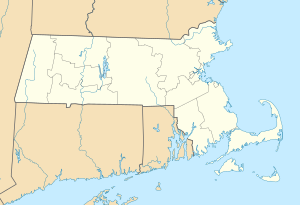Charlestown Bridge
Coordinates: 42 ° 22 '8 " N , 71 ° 3' 36" W.
| Charlestown Bridge | ||
|---|---|---|
|
The Charlestown Bridge looking north. The red line marks the Boston Freedom Trail . |
||
| use | Cars, trucks, pedestrians | |
| Convicted | (New) Rutherford Avenue | |
| Crossing of | Charles River | |
| place | Boston , Massachusetts , United States | |
| Entertained by | Massachusetts Department of Transportation | |
| start of building | 1898 | |
| opening | 1900 | |
| planner | William Jackson | |
| location | ||
|
|
||
|
Previous structure: Charles River Bridge (1786) |
||
The Charlestown Bridge is the easternmost bridge over the Charles River in Boston in the state of Massachusetts in the United States . The southernmost section of Massachusetts Route 99 , which now ends at Chelsea Street in Charlestown , used to run over the bridge . The structure connects Joe Tecce Way in the south with Rutherford Avenue in the north. The Boston Freedom Trail , recognizable by the red trail markings , also leads over the bridge .
history
Charles River Bridge
As early as 1630, there was a government-approved ferry at this point that carried passengers and material across the Charles River. It was run by various people until it was transferred to Harvard College for permanent funding .
The first bridge built to replace the ferry was the Charles River Bridge, opened on June 17, 1786 . As a condition for the construction of the bridge, Harvard College had to be paid £ 200 annually to make up for the lost revenue from the loss of ferry operations. The bridge was financed, built and operated by private individuals, which was mainly financed by tolls that had to be paid by anyone who wanted to use the bridge. In 1792 the West Boston Bridge was opened, connecting western Boston with Cambridge . To compensate, the lease of the Charles River Bridge to its investors was extended by 30 years, although the doubled tolls on Sundays were abolished. Traffic on the bridge increased significantly with the construction of the Medford Turnpike in 1803.
When the Warren Bridge was built in the immediate vicinity in 1828 where the Charles River Dam is located today , the investors in the Charles River Bridge filed a lawsuit and brought it to the United States Supreme Court .
Charlestown Bridge
The current bridge was designed by engineer William Jackson at the end of the 19th century and opened in 1900. The Charlestown Elevated led over the bridge until it was demolished in 1975 .
In art
The bridge plays a role in the feature film The Town - City Without Mercy (2011): It is closed after a robbery.
See also
Web links
Individual evidence
- ↑ a b Yanni Kosta Tsipis: Boston's bridges (= Images of America ). Arcadia Publishers, Charleston SC 2004, ISBN 978-0-7385-3571-5 .
- ^ The Harvard College Ferry. Kellscraft Studio, accessed October 5, 2012 .
- ^ Edwin Munroe Bacon, George Edward Ellis: Bacon's dictionary of Boston . Houghton, Mifflin and Co., Boston / New York 1886, OCLC 1228799 ( online in the Google book search).
- ↑ trial Charles River Bridge v. Warren Bridge . ( Wikisource , English)
- ^ Toni Konkoly: Charles River Bridge v. Warren Bridge (1837). In: Supreme Court History. Retrieved October 5, 2012 .
|
Upstream Charles River Dam |
Crossing the Charles River Charlestown Bridge |
Downstream confluence with Boston Harbor |


